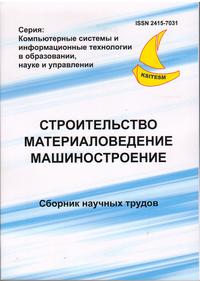The application programs of finite element methods (fem) simulation system operation of «base - engineering constructions»
Keywords:
contact tensions, undermined territories, retaining wall of a special type, PLAXISAbstract
Abstract. Purpose. In practice, the design and operation is necessary to assess the possibility of deformation structures located on the grounds, which are possible uneven rainfall and subsidence. Only with reliable and detailed definition of the stress-strain state of structures designs in conjunction with the soil mass in the simulation can be reasonably applied to the FEM practice. Methodology. The present level of computer hardware and software allows you to perform more accurate calculations of the stress state of fairly complex systems. For some programs possible solution not only linear but also nonlinear problems. This provid es accounting features of deformation of different materials: concrete, steel, soil, etc. To take into account the work of the soil developed several models that take into account the transition of soil in a plastic state, the elastic deformation and other models. A comparison should be of adequate models and testing them to solve practical problems. Currently, the most widely used several large programs, developed in theUnited States,Western Europe,UkraineandRussia. InUkraine, widespread program of Lira-Windows, Monomakh, SCAD - Office, which focused mainly on estimates of construction projects. In the world a large amount of problems solved with the programs ANSYS, PLAXIS, SolidWorks, LS-DYNA, Midas GTS NX and others. Originality. Calculations using PLAXIS program allowed an analysis of the stress-strain state of the soil mass and stability of retaining walls: I option - the prototype, angular retaining wall: II option - retaining wall of a special type. At the same ground-based (the geometry of the layers and the physical and mechanical properties), loads and boundary conditions, load obvious presence of the II option included in the work of the whole array of ground and uniform redistribution of stresses on the front and the base plate (for common voltage) is uniformly total deformation structures and ground a base, which in turn provides greater stability of the retaining wall (mot ion picture on the total). Practical value. The validity of the theoretical prediction of behavior of engineering structures, interacting with non-uniformly deformed-basics can not be obtained on the basis of the regulatory framework. This gap can be filled in the simulation system "foundation - engineering facility" with the help of modern calculation FEM programs.
References
Alyamovskiy A.A., Sobachkin A.A., Odintsov E.V., Kharitonovich A.I. and Ponomarev N.B. SolidWorks. Kompyuternoe modelirovanie v inzhenerny praktike [Computer modeling in engineering practice]. Saint-Petersburg: BHV-Peterburg Publ., 2005, 800 p. (in Russian)
Basov K.A. ANSYS dlya konstruktorov [ANSYS for designers].Moscow, DMK Press Publ., 2009, 248 p. (in Russian)
Krivosheiev P.І. Naukovo-tekhnіchnі problemy koordinatsiie dіy shchodo zakhystu budіvel, sporud і terytorіy zі skladnymy іnzhenerno-heolohіchnymy umovayi [Scientific and technical problems of coordination for the protection of buildings, structures and areas with complex engineering-geological conditions]. Budіvnytstvo Ukraieny [BuildingofUkraine]. Кyiv, 2001, no. 6. – pp. 16-19. (in Ukrainian)
Vіlkul Yu.G., Tіmchenko R.O., Krіshko D.A., Dmitrієva K.Y. and Bondar Y.M. Pіdpіrna stіnka [Retaining wall] Patent UA no. u 2003054146; 2003. (in Ukrainian)
Prokhorenko V.P. SolidWorks. Prakticheskoe rukovodstvo [SolidWorks. Practical guidance]. Moscow, Binom-Press Publ., 2004, 448 p. (in Russian)
Strokova L.A. Opredelenie parametrov dlya chislennogo modelirovaniya povedeniya gruntov [Determining the parameters for the numerical simulation of the behavior of soils] . Izvestiya Tomskogo politekhnicheskogo universiteta, 2008, vol. 313, no. 1. pp. 59 65. (in Russian)
Tіmchenko R.O. Proektuvannia і rozrakhunok pіdpіrnykh stіn [Design and calculation of retaining walls]: Navch. posіb. dlya vishch. navch. zaklad. – Kriviy Rіg, Mіneral Publ., 2005, 136 p. (in Ukrainian)
Timchenko R.A. Uchet slozhnogo nagruzheniya dlya plitnykh fundamentov v usloviyakh neravnomernykh deformatsiy osnovaniya [Accounting for the complex loading of plate bases in non-uniform strain base conditions]. Vіsnik Akademії, Dnipropetrovsk, 2007, no. 7, pp. 24 - 29. (in Russian)
Shapiro D.M. Metod konechnykh elementov v stroitlnom proektirovanii [The finite element method in structural design]: monografiya].Voronezh, Nauchnaya kniga Publ., 2013, 181 p. (in Russian)
Benson David J. The History of LS-DYNA.UniversityOfCalifornia,San Diego. –San Diego, 2009, 37 р.
LSTC. LS-DYNA Keyword User's Manual, Volume 1. Livermore Software Technology Corporation (LSTC). Versi on 971. –California, 2007, 1384 p.
Plaxis 2D 2015. Reference manual,DelftUniversityof Technology & PLAXIS b.v., The Netherland, 424 p.
R.B.I. Brinkgreve. P.A. Vermeer. PLAXIS B.V. Version 7. –Rotterdam,Brookfield, 1998, 70 p.
Downloads
Published
Issue
Section
License
Редакція Видання категорично засуджує прояви плагіату в статтях та вживає всіх можливих заходів для його недопущення. Плагіат розглядається як форма порушення авторських прав і наукової етики.
При виявлені у статті більш ніж 25% запозиченого тексту без відповідних посилань та використання лапок, стаття кваліфікується як така, що містить плагіат. У цьому випадку стаття більше не розглядається редакцією, а автор отримує перше попередження.
Автори, в статтях яких повторно виявлено плагіат, не зможуть публікуватися в усіх журналах Видавництва ДВНЗ «Придніпровська державна академія будівництва та архітектури».
Автори, які публікуються у цьому журналі, погоджуються з наступними умовами:
- Автори залишають за собою право на авторство своєї роботи та передають журналу право першої публікації цієї роботи на умовах ліцензії Creative Commons Attribution License, котра дозволяє іншим особам вільно розповсюджувати опубліковану роботу з обов'язковим посиланням на авторів оригінальної роботи та першу публікацію роботи у цьому журналі.
- Автори мають право укладати самостійні додаткові угоди щодо неексклюзивного розповсюдження роботи у тому вигляді, в якому вона була опублікована цим журналом (наприклад, розміщувати роботу в електронному сховищі установи або публікувати у складі монографії), за умови збереження посилання на першу публікацію роботи у цьому журналі.
- Політика журналу дозволяє і заохочує розміщення авторами в мережі Інтернет (наприклад, у сховищах установ або на особистих веб-сайтах) рукопису роботи, як до подання цього рукопису до редакції, так і під час його редакційного опрацювання, оскільки це сприяє виникненню продуктивної наукової дискусії та позитивно позначається на оперативності та динаміці цитування опублікованої роботи (див. The Effect of Open Access).

